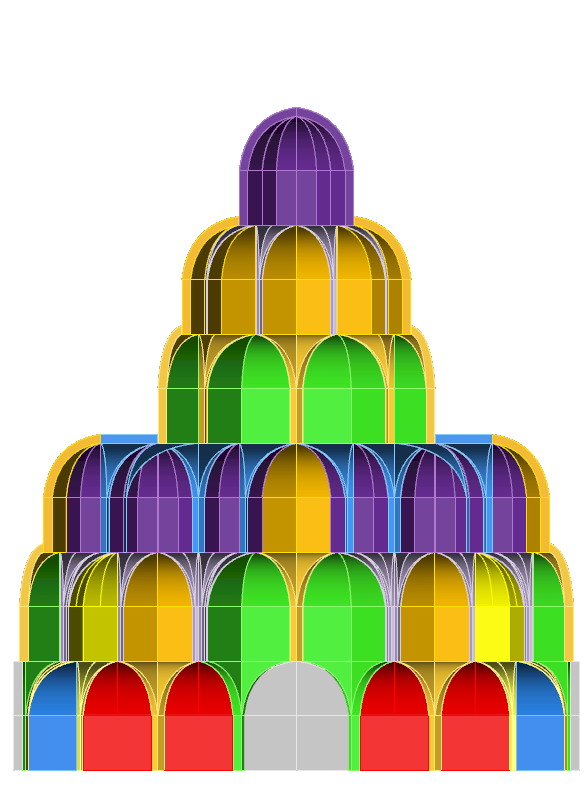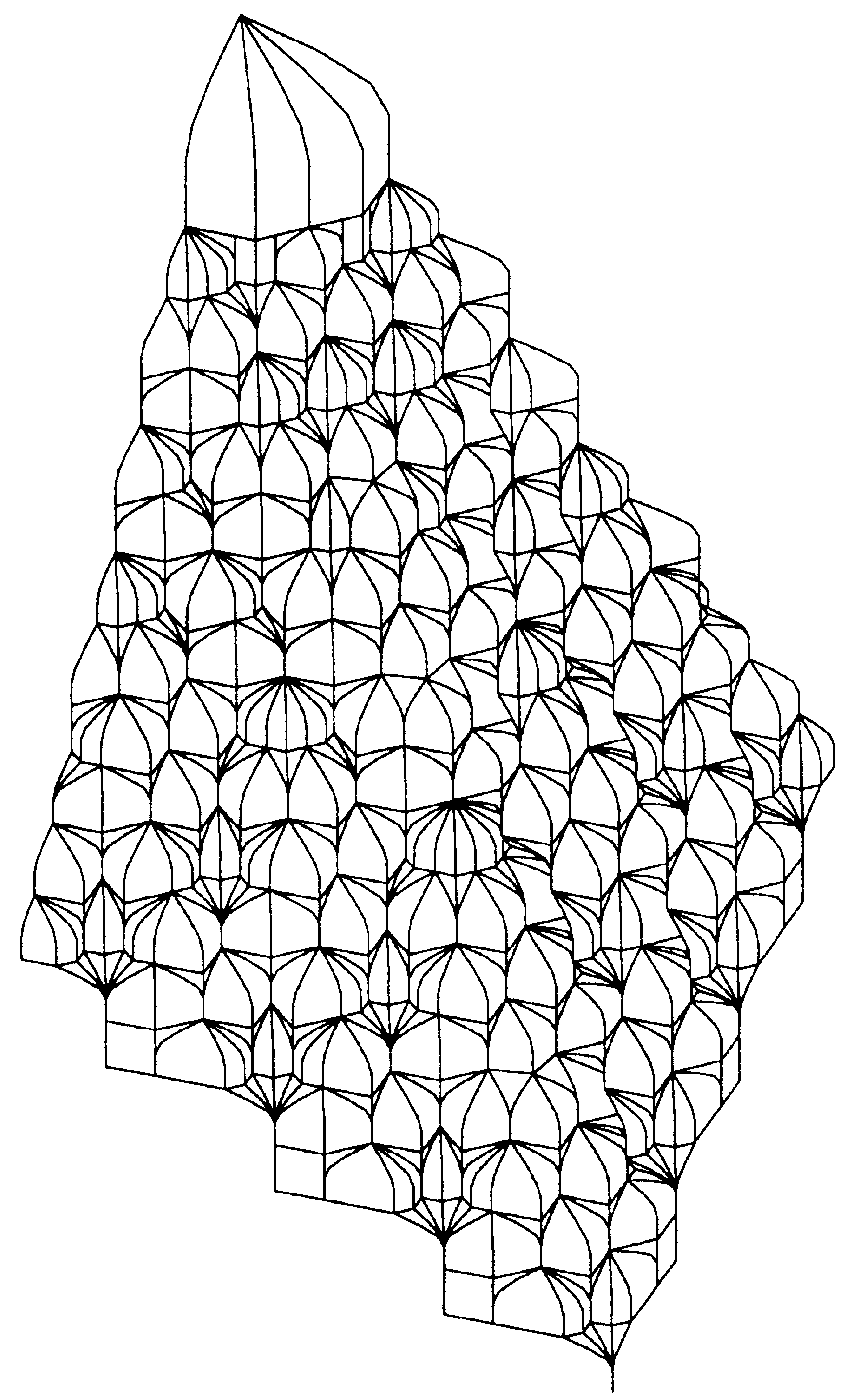DebateWhen a 3D muqarnas structure is projected onto a flat surface, it creates a pattern like a tessellation. But this 2D version doesn't capture all the details of the original 3D design. That raises a question: can a flat pattern fully describe the 3D structure it came from? This ambiguity has sparked debate, especially around a gypsum plate found in the southern octagon of Takht-i Sulayman. The main challenge is figuring out how to "elevate" a 2D plan: how to turn a flat layout into a 3D form using known muqarnas building blocks From 1959 to 1978, a German archaeological team dug at the Takht-i Sulayman site in northwestern Iran, south of Tabriz. They found broken pieces of muqarnas in the southern octagon. Harb created technical drawings of the pieces and put together a possible floor plan. Later, Yaghan revised this plan. Based on this, I explored different ways the muqarnas might have been built, trying out several combinations of standard units to see which version made the most sense. The images here show six of these possibilities. One important find was a gypsum plate with a carved geometric design, thought to be a muqarnas pattern. This object has been studied by several researchers, including Harb (1978), Yaghan (2000), Dold-Samplonius (2005), and Senalp (2012).
|
Reconstruction Takht-i Sulayman Southern Octagon
This is a reconstruction of the famous Takht-i Sulayman Southern Octagon muqarnas. Unfortunately, the original no longer exists, but Harb found so many remains that he could reconstruct the muqarnas units and the muqarnas design.
Below, there are two series of interpretations. The top row shows Alternative Design A, B, and C. Blue squares are implemented in this row. The bottom row shows Alternative Designs A+, and C+. Here many orange jugs and bipeds have been assigned instead of blue squares. The aesthetic appeal of most subjects is questionable.
Neither Alternative Design A, B or C is attractive: Alternative A and C are unbalanced, and Alternative B seems compressed. Alternative Design C+ suffers from the same imbalance, but A+ seems to be the most balanced of all.
Yaghan's perspective drawing of Harb's idea is the same as my Alternative Design B, the most harmonious one in the series A, B and C.
My Alternatives
Six alternatives are presented below. Three have squares, one has jugs and bipeds, two have squares and jugs and bipeds.
Gypsum Plate
A gypsum plate was found with a quarter of what was recognised to be a muqarnas design. It was studied by Harb (1978), Yaghan (2000), Dold-Samplonius (2005), and Senalp (2012). Their articles contain floor plans and perspective drawings. Here I present full color assignments and STL animations for a better 3D experience.
Harb had a totally different plan in mind than the usual Iranian muqarnas. Yaghan objects and came up with alternatives. Dold and Harmsen also had ideas. Senalp politely rejects their proposal.
The discovery of a drawing of a muqarnas vault dated to 1270's in Takth-i Suleyman has sparked academic discussions on how to interpret those drawings on third dimension. First to interpret the plan into third dimension was Harb (1978). Later, Yaghan (2000) made a new interpretation by indicating Harb's mistakes. Lastly, Dold-Samplonius and Harmsen (2005) indicated that both were wrong. In all those studies, it is argued that each particular study fits well with the historical context. Among those, Dold-Samplonius and Harmsen's work is important because the study takes its stand from Timurid mathematician al-Kashi's treatise, Key to Aritmetics (ca 1430) which is important for our modern understanding of muqarnas. However, the interpretation of Dold-Samplonius and Harmsen is doubtful. Those scholars, writing on muqarnas plans actually putting forward puzzling interpretations, without having a full knowledge of how a geometric schema may established first, and what are the interrelations of geometric forms between two tiers, upper and lower. Although this study exploits al-Kashi, our understanding of muqarnas still remains obscure, and there should be ample analysis studying wide range of muqarnas plans.
- Senalp: Mukarnas yapim teknikleri ve koruma problemleri
- Yaghan: Decoding the Two-Dimensional Pattern Found at Takht-I Sulayman into Three-Dimensional Muqarnas Forms
Reconstruction of the Gypsum Plate
With a little effort, one can read the pattern from the gypsum plate. The reconstruction shows squares, rhombuses and triangles. Dold-Samplonius points at the shapes on the diagonal. They are not the usual octagonal shapes. In her approach, she modifies this part of the floor plan to common jugs, isosceles triangles and jugs. On the other hand, the muqarnas might have had these exceptional shapes.
Note: for clarity, I rotated all figures to the same orientation. Although, the gypsum plate contains just a quarter of the muqarnas, my drawings show only half of the vault because of the difficulty of looking into the rendering of a full 3D vault. All drawings are computer-generated, so I can do either quarter, half or full in a second.
Harb was first in 1978, next Yaghan in 2000 and Dold-Samplonius was last in 2005. Harb had a particular muqarnas in mind with long tails in the corners, like the Western Islamic muqarnas. Yaghan and Dold-Samplonius reconstructed the floor-plan and of course I did too. We all share the same floor-plan. The perspective drawing in the article figures are too small for a comparison. Therefore I produced a 3D rendering myself. An interactie animation is available to turn the muqarnas to any position.
Dold-Samplonius and Harmsen point at the irregulat shapes on the diagonal. It is not a square, it is not a jug, but something inbetween. My implementation is a square because the drawing suggests a square, but a jug might have been more appropriate in version I of the upper part.
Yaghan stated that there are reasons to believe that the muqarnas was a vault without tails. In his figure 8 he explained the difference in interpretation. At the left, the way Harb decoded the gypsum plate, at the right the opinion of Yaghan. Yaghan split the muqarnas in an upper part and a lower part, which, according to Ödekan, is not unusual for large portal or vault muqarnas He proposed two alternative for the upper part and two for the lower part of the muqarnas.
My interpretations of Yaghan's designs leave a gap I can not fill with my pre-defined units. There is a gap in the connection of the fifth yellow tier and the sixth pink tier (counted from the top). The same happens in the second version of the bottom part of the muqarnas.
- Reconstruction by Harb
- Reconstruction by Yaghan
- Reconstruction by Dold-Samplonius and Harmsen
Harb's Reconstruction of the Gypsum Plate
Harb thought of a vault with long tails starting in the corners. His images show one quarter of the vault. My images show half of the vault.
Comparison
It might be hard to notice the difference in the floor plan, although all information is available: tiers, units, upward curvature, etc.. The difference in 3D view is striking and the STL viewer is of great help. 3D modelling and 3D printing helps to investigate the true mature of these muqarnas.
The color-coding system as detailed before is based on the available 3D-printer filaments. Each unit is 3D-printed with a unique color, making distinctions clear. In some gypsum plate interpretations, units such as the orange jug (D) and large biped (J) replace the blue squares (A). This underscores how a single tessellation can generate multiple configurations with varying units and tier arrangements. 3D software and 3D printing visualizes these alternatives, allowing me to analyze and refine the most harmonious design.
Conclusion
This example of the Southern Vault and the gypsum plate demonstrates that the tiers of a muqarnas can be constructed in multiple ways, each leading to a distinct structure. Consequently, the front views of these variations differ significantly. The approach of Ödekan, Tuncer and Uluengin to present both the floor plan and the front view makes sense. The front view helps to interpret the floor plan.
My favorite design of the Southern Octagon is alternative B+. The solution of Harb for the central dome is a possibility. Experts can tell whether his solution fits in the cultural artistic timeframe. The version of Yaghan is more harmonius than the idea of Dold-Samplonius and Harmsen because too many different units are mixed in each tier. So, the question rises of the intention of the gypsum plate: with or without tails.












 Open STL file in a new window
Open STL file in a new window




































